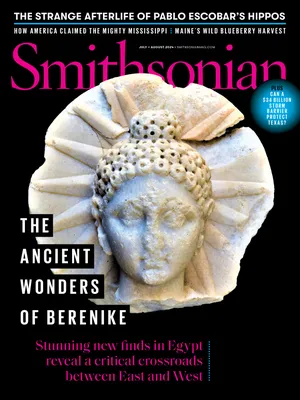How Dungeons & Dragons Sparked a Revolution in How We Play Just About Everything
Created more than 50 years ago, the game has captured the imaginations of generations of Americans, and not just the nerdy ones
:focal(890x712:891x713)/https://tf-cmsv2-smithsonianmag-media.s3.amazonaws.com/filer_public/4d/77/4d77afb8-ecba-4fe3-80f8-48727cd84480/julaug2024_c11_prologue.jpg)
In February 1973, Dave Arneson, a history major at the University of Minnesota and part-time security guard, drove with a friend from the Twin Cities to the resort town of Lake Geneva, Wisconsin. They were on a quest to meet Gary Gygax, an insurance underwriter. What brought the three together was a deep devotion to playing strategic tabletop war games. Gygax had co-written a medieval fantasy game inspired by The Lord of the Rings, full of elves and orcs. Together, the trio embarked on a novel approach: Instead of pitting player against player, Arneson suggested having all characters fight their way together through a mystical realm—sometimes as friends, sometimes as foes—under the watchful eye of what Arneson envisioned as a “sadistic referee.” Gone was author J.R.R. Tolkien’s Shire. In its place? The Dungeon.
That cold visit in Wisconsin convinced Arneson and Gygax that this nascent game was worth pursuing, so the two quickly established the basic rules for what they decided to call Dungeons & Dragons. The following year, Gygax’s new gaming company, Tactical Studies Rules (later TSR), published the first publicly available rules for D&D, explained in three slim booklets: one on how to make a character, another on monsters and treasure, and a final one of scenarios for adventures. The illustrations were amateurish; the print quality low; the concepts mere sketches of ideas about how to create characters and goals. But over the past 50 years, those first booklets revolutionized tabletop games—and established the imaginative basis for the video games that were about to consume a huge chunk of the entertainment industry. As Dan Rawson, senior vice president of Wizards of the Coast, the company that makes the game today, says: “The nerds emerged from the basement.”
The early game was a mess, requiring players to improvise constantly. What really helped develop it was a national network of gamers who collaborated at conventions and communicated via self-published magazines. This network was primed to analyze any new tabletop game, figure out what did and didn’t work—and then spread the word.
Compared with war games of the era—which tended to model real-world military conflicts with lots of tokens or pieces, so you could play out a Civil War battle with Gettysburg, for example—D&D offered something immersive and even serene, enchanting gamers in college dorms around the country by allowing groups of players to tour an imaginary space in collective wonder. When a character did come upon a battle, they could level up indefinitely, growing in power session after session, even year after year, attaining higher ranks with more experience points as they moved through the game. D&D thus offers a sort of comforting feedback loop, where improving in the game feels good, so you want to keep gaming, so you can keep improving—and the story never has to end. Both experience points and collective exploration were new. People loved it.
/https://tf-cmsv2-smithsonianmag-media.s3.amazonaws.com/filer_public/ae/40/ae40bb83-6dfa-48a9-a50e-a590ee68edfe/julaug2024_c05_prologue.jpg)
Within its first decade, D&D sales soared to more than $16 million a year. But its success also provoked a bitter legal fight between Gygax and Arneson over royalties and credit. During the 1980s, some Parent Teacher Associations and school administrators began to denounce the game, full of occult lore, as un-Christian and even devilish, and many schools banned D&D amid periodic paranoias now known as the “Satanic Panic.” When I was a Boy Scout in Nashville in that era, my Baptist scoutmaster told me I had to choose between playing D&D, which he equated to demon worship, and “leveling up” as a Boy Scout. I never became an Eagle Scout.
Today, leveling up is everywhere. It has become the norm among the games for which consumers spend hundreds of billions of dollars every year—not to mention a key strategy by game-makers to keep players glued to the screen in hopes of everlasting advancement. But D&D’s legacy goes far beyond tabletop or video games to include the “gamification” that you encounter every time you gain a new badge or rank with a credit card or hotel loyalty program. As D&D marks its 50th anniversary this year, and amid massive ongoing enthusiasm for fantasy realms, the newest versions of the game have become wildly popular: Between the recent Dungeons & Dragons movie, video games and the tabletop original, the franchise, now owned by Hasbro, claims 54 million fans worldwide. And the game itself is more accessible than ever—not least because of YouTube, where you can watch people playing D&D and learn new gambits.
It turns out that what Gygax and Arneson and all their first-generation wizards and clerics created was a vehicle for human imagination—the power to create and inhabit fantasy worlds where the delights and marvels have not dimmed after half a century. In other words, we’re all nerds now, no basement required.
